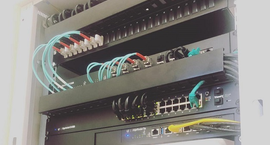FAQ - Copper Cable
UTP, FTP etc. What does it all mean and what is the difference?
When shielding is applied to the collection of pairs, this is usually referred to as screening, however different vendors and authors use different terminology, employing "screening" and "shielding" interchangeably; for example, STP (shielded twisted pair) or ScTP (screened twisted pair) has been used to denote U/FTP, S/UTP, F/UTP, SF/UTP and S/FTP construction). Because the shielding is made of metal, it may also serve as a ground. Usually a shielded or a screened twisted pair cable has a special grounding wire added called a drain wire which is electrically connected to the shield or screen. The drain wire simplifies connection to ground at the connectors. Common shielded cable types used by Cat. 6a, Cat.7 and Cat.8 cables include:
Shielded twisted pair (U/FTP)
Also pair in metal foil. Individual shielding with foil for each twisted pair or quad. This type of shielding protects cable from external EMI from entering or exiting the cable and also protects neighboring pairs from crosstalk.
Screened twisted pair (F/UTP, S/UTP and SF/UTP)
Also foiled twisted pair for F/UTP. Overall foil, braided shield or braiding with foil across all of the pairs within the 100 Ohm twisted pair cable. This type of shielding protects EMI from entering or exiting the cable.
Screened shielded twisted pair (F/FTP and S/FTP)
Also fully shielded twisted pair, shielded screened twisted pair, screened foiled twisted pair, shielded foiled twisted pair. Individual shielding using foil between the twisted pair sets, and also an outer metal and/or foil shielding within the 100 Ohm twisted pair cable. This type of shielding protects EMI from entering or exiting the cable and also protects neighboring pairs from crosstalk.
Cat5e, Cat6 and Cat6a are available in unshielded and shielded formats, Cat7, Cat7a cables are only available as a shielded cable. (Cat 8.1 and 8.2 are unratified at time of going to print).
For more information on Category
Examples of common industry abbreviations
| Industry acronyms | Name | Cable screening | Pair shielding |
|---|---|---|---|
| UTP | U/UTP | none | none |
| STP, ScTP, PiMF | U/FTP | none | foil |
| FTP, STP, ScTP | F/UTP | foil | none |
| STP, ScTP | S/UTP | braiding | none |
| S-FTP, SFTP, STP | SF/UTP | braiding, foil | none |
| FFTP | F/FTP | foil | foil |
| SSTP, SFTP, STP PiMF | S/FTP | braiding | foil |
Maximum distances on different types of copper cable
The distances achievable using the different categories of Copper cables are illustrated in the following table.
Solid Core cable uses one solid wire per conductor, the cable is less flexible than stranded cable and is used primarily for premises cabling due to its low attenuation
Stranded Cable consists of multiple strands of wires wrapped around each other in each conductor. It is primarily used for patch cables due to its high attenuation
The Distances shown for solid cable in the table below are accurate, the distances for stranded are approximate and vary according to the quality of the cable:
| Ratified Standard | Speed Achievable | Transmission Frequency | Distance (Stranded) | Distance (Solid) |
|---|---|---|---|---|
| Cat5e | Up to 1Gb | 100MHz | 65m | 100m |
| Cat6 | Up to 1Gb | 250MHz | 65m | 100m |
| Cat6a | Up to10Gb | 500MHz | 65m | 100m |
| Cat7 | Up to10Gb | 600MHz | 65m | 100m |
| Cat7a | Up to 100Gb* | 1000Mhz | 65m | 100m |
* 100 GB achievable only up to 15m
For more information on these standards, Wikipedia has some useful information:





